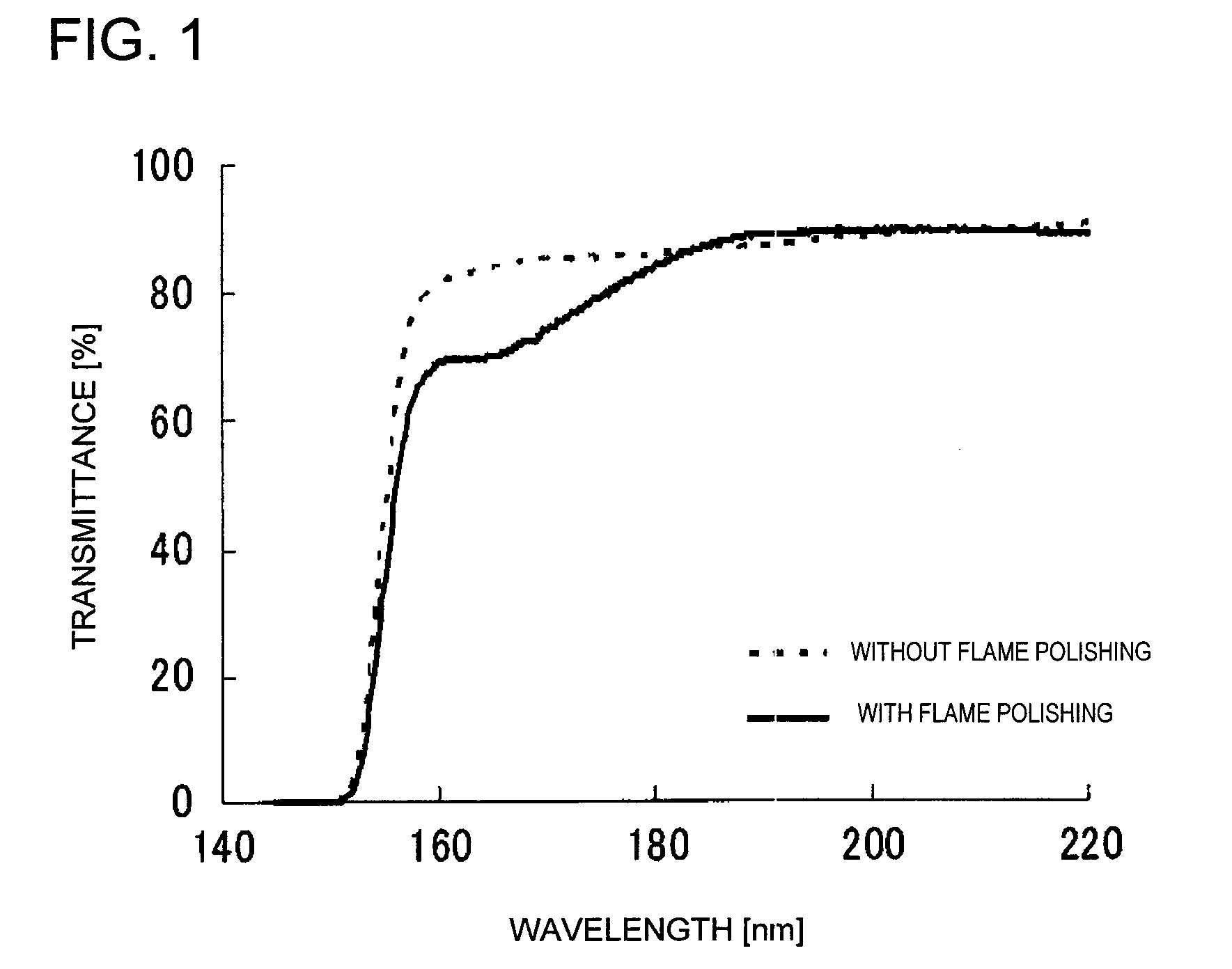Energy-transmitting or ultraviolet light-transmitting optical fiber preform and production process thereof
a technology of energy-transmitting or ultraviolet light-transmitting optical fiber and production process, which is applied in the direction of glass making apparatus, manufacturing tools, instruments, etc., can solve the problems of low transmittance, great loss, and inability to transmit, and achieve excellent durability and low transmission loss
- Summary
- Abstract
- Description
- Claims
- Application Information
AI Technical Summary
Benefits of technology
Problems solved by technology
Method used
Image
Examples
examples 1 to 3
[0151]Core materials and cladding materials were produced by a VAD method. The F concentration and OH concentration in each sample were adjusted by the F compound gas concentration, temperature, etc. at the time of treating a porous silica glass body with an F compound gas.
[0152]The produced core materials and cladding materials were processed by a peripheral grinding machine and a cylinder grinding machine and then polished with an abrasive grain for polishing GC #240, GC #400, FO #600, FO #800 and FO #1000 (trade names, produced by Fujimi Corp.) each formed into a slurry. Thereafter, precision polishing was performed using MIREK (trade name, produced by Mitsui Mining & Smelting Co., Ltd.). In the core materials and cladding materials after precision polishing, the non-circularity was 2 or less, the particle was 0.1 μm or less in diameter, and the scratch was 11 μm in width. Subsequently, precision cleaning was applied in place of a usual flame polishing step using oxyhydrogen flam...
example 4
[0153]A core material and a cladding material were produced by a VAD method in the same manner as in Examples 1 to 3. The produced core material and cladding material each was subjected to usual polishing using alumina and cerium oxide and then to a flame polishing process using oxyhydrogen flame. The flame polishing of the cladding material was performed by a method of treating the outside with oxyhydrogen while allowing an oxygen gas to flow in the inside. Here, the temperature raise of the core material and the cladding material in the flame polishing step was measured with a radiation thermometer (Marathon MM-Model G5H, produced by Raytek Corporation). The measurement value was 2,000° C.
[0154]The dotted line in FIG. 1 shows the transmittance spectrum measured by making rays incident in the direction perpendicular to the side face of the core material of the sample not subjected to flame polishing (Example 1). The solid line in FIG. 1 shows the transmittance spectrum measured wit...
examples 5 to 8
[0163]A cladding was formed on the core materials of Examples 1 to 4 by using a VAD method to produce fiber preforms.
[0164]The measurement results (average) of the OH concentration, O2 concentration, ODC (I) concentration, ODC (II) concentration and F concentration in the core and cladding of each preform are shown in Table 5.
TABLE 5OHO2ODC (I)ODC (II)FConcentrationConcentrationConcentrationConcentrationConcentration(ppm)(molecules / cm3)(defects / cm3)(defects / cm3)(ppm)Example 5Core1≦1 × 1016≦1 × 1012≦1 × 1012300Cladding≦1≦1 × 1016≦1 × 1012≦1 × 10127500Example 6Core5≦1 × 1016≦1 × 1012≦1 × 1012200Cladding≦1≦1 × 1016≦1 × 1012≦1 × 10128300Example 7Core8≦1 × 1016≦1 × 1012≦1 × 1012150Cladding≦1≦1 × 1016≦1 × 1012≦1 × 101213500Example 8Core5 1 × 1017 8 × 1015 8 × 1015200Cladding≦1≦1 × 1016≦1 × 1012≦1 × 10128500
[0165]The measurement results (average) of the OH concentration, O2 concentration, ODC (I) concentration, ODC (II) concentration and F concentration in the regions of ±10 μm and ±20 ...
PUM
| Property | Measurement | Unit |
|---|---|---|
| Fraction | aaaaa | aaaaa |
| Fraction | aaaaa | aaaaa |
| Fraction | aaaaa | aaaaa |
Abstract
Description
Claims
Application Information
 Login to View More
Login to View More - R&D
- Intellectual Property
- Life Sciences
- Materials
- Tech Scout
- Unparalleled Data Quality
- Higher Quality Content
- 60% Fewer Hallucinations
Browse by: Latest US Patents, China's latest patents, Technical Efficacy Thesaurus, Application Domain, Technology Topic, Popular Technical Reports.
© 2025 PatSnap. All rights reserved.Legal|Privacy policy|Modern Slavery Act Transparency Statement|Sitemap|About US| Contact US: help@patsnap.com


